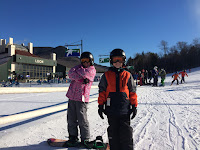Necessity
There is a certain amount of writing that we all have to do out of necessity. We may need to write a list, fill out an application, send an email, draft a proposal, dismiss a child from school or any of a wide variety of things that come up as part of our personal and professional lives. Most adults are not able to escape at least some point in their day when they need to communicate something in writing.Agreement and Understanding
 There are other times, depending upon our specific life circumstances, when we have to write things down as a way of cementing an understanding, sharing information, communicating a message or providing direction. For example, I have two children (aged 8 and 11) that, if allowed, would spend every free minute in front of some type of screen. Left to their own devices (pun intended) they would bounce from television to Xbox to Kindle Fire for each of their waking minutes, shutting themselves off from the rest of the world and from the family.
There are other times, depending upon our specific life circumstances, when we have to write things down as a way of cementing an understanding, sharing information, communicating a message or providing direction. For example, I have two children (aged 8 and 11) that, if allowed, would spend every free minute in front of some type of screen. Left to their own devices (pun intended) they would bounce from television to Xbox to Kindle Fire for each of their waking minutes, shutting themselves off from the rest of the world and from the family.
My wife and I have decided that this is not the way we want to raise our children. Instead, we have chosen to ensure they have more balance in their lives and as a result have put adult limits on the amount of "screen time" they are allowed. After much conversation, we decided to create a system where our kids could "earn" screen time based upon the completion of certain activities (playing outside, exercise, reading, chores, etc.) that would translate to a set number of minutes that they could "spend" on screen time. After discussing the new expectations with the kids, we decided that we should type them out and post them on the refrigerator to ensure we all had a common expectation and common reference should there be any confusion.
Personal Reflection
In preparing for my presentation, I came across this quote from Anais Nin, "We write to taste life twice, in the moment and in retrospect." As I read this quote for the first time, I felt like it did a great job of encapsulating the way I feel about the power of writing. For me, I find that taking the time to write is the best way to both do my thinking in the present and reflect upon the learning and life experiences that have brought me to that thinking.
Those that know me well, know that I spend a lot of time thinking. Some may even say that I perseverate a bit :-/ There are very few points during a day when I am not considering something I have read, an action I have taken, an upcoming conversation or any of a hundred other things. The problem that I run into is that my thinking also bounces around a lot. Part of it is the way my brain works and part of it is the nature of being a principal. The principalship throws new and interesting challenges at you multiple times a day. Often those challenges are complex and need to be considered from more than one angle before a decision can be made and often my thinking bounces from one challenge to the next.
Additionally, principals have a responsibility for enhancing the culture within their school and community. Leaders are key factors in championing the values of the organization, communicating them to all the stakeholders and ensuring that the organization lives up to those values. In order to do this well, a leader has to take the time to organize his/her own thinking. The message being communicated can not bounce around, meander or get lost. This is where I find writing so helpful.
Writing forces me to slow down, to consider my words carefully for their meaning, to organize my message, to consider my audience, and to follow my thinking to some sort of an end. I use this type of writing a lot. Often, it is never published. It is only for me; it is a way to process my thinking and I find the practice helps both the writing I do publish as well as clarifying the messaging I do with oral communication. I have also found that writing for this purpose makes me better at the first two purposes I have laid out.
Sharing of Ideas
As each year passes in my life and in my time as a leader, I grow a deeper understanding of the ways that our communication affects our relationships. If we agree on the definition of communication to be a two way sharing of ideas, of both taking in the ideas of others and the sharing of your own ideas then we can see how integral communication is to building strong relationships. I have learned that taking the time to write ultimately helps me in my communication skills which in turns strengthens my relationships. The written word allows us the time to experience our thoughts in the moment, as we type them, while simultaneously bringing previous life experience, thoughts and ideas to bear on our current thinking.






